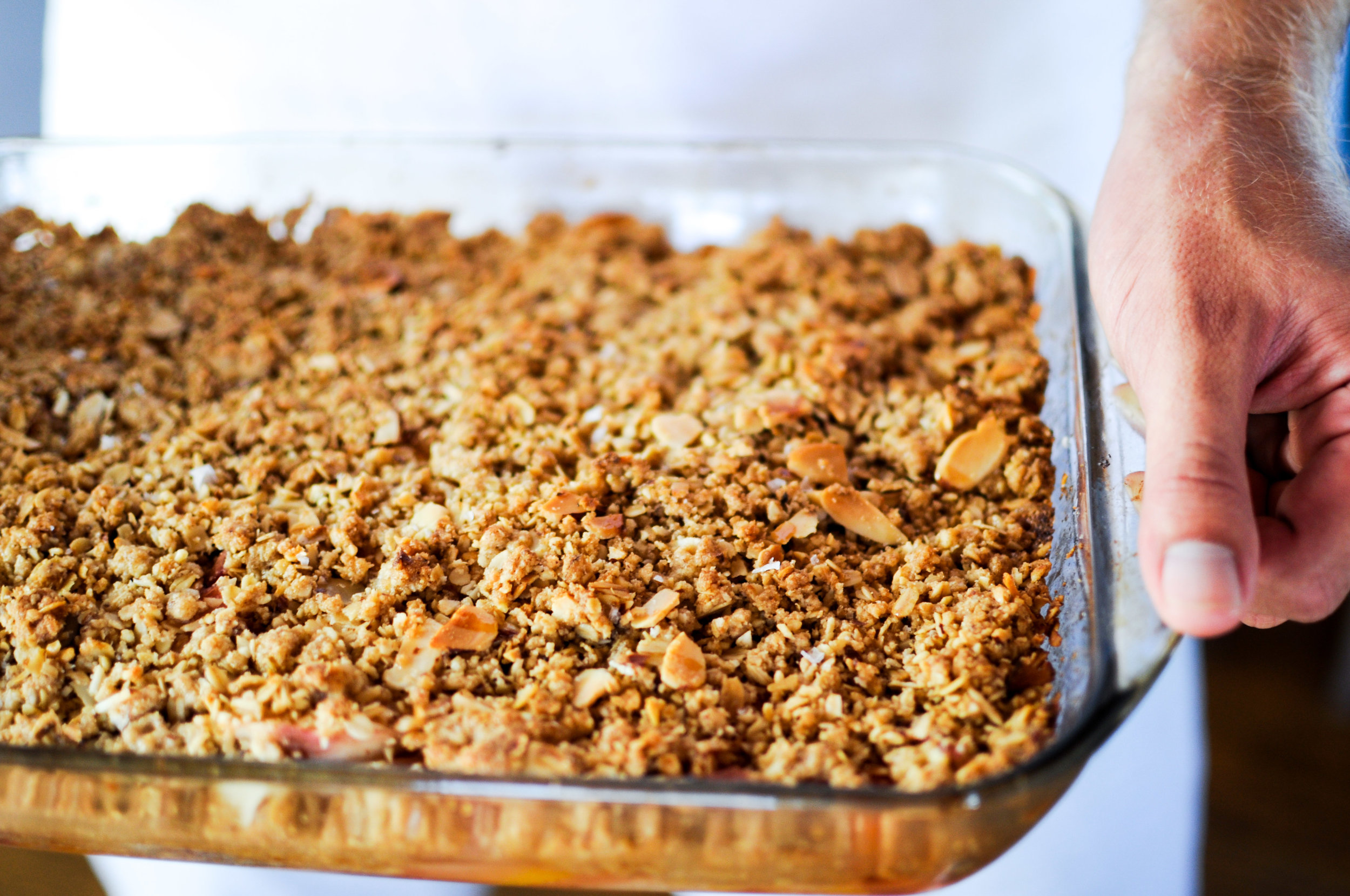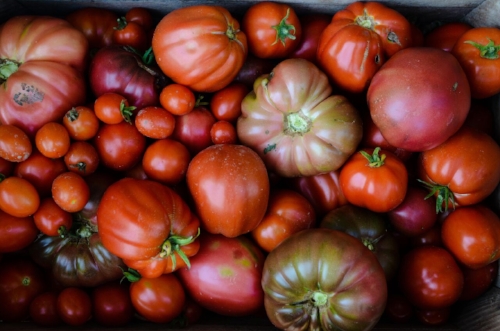Where is your farm located and what to you grow? Our farm is located in the piedmont region of North Carolina, in the town of Staley. My husband Patrick and I began leasing a 16 acre historic farmland property in January that we found through NC Farm Link. We have about 1 acre of the land in cultivation, growing many different vegetables, cut flowers, and medicinal herbs. We also pasture raise chickens for personal consumption and recently acquired our first bee hive.
Walk us through a typical day on your farm and in your kitchen (ie what do you eat on a typical day)? We usually wake up shortly after sunrise, attending to our cat, new puppy, and chickens first thing after we rise. Once the animals are taken care of, we put on a pot of coffee which to us feels like a sacred ritual. We love everything about it – picking out a great roasted bean, the smell and sound of grinding the beans, and adding the grounds to our French press or our good old Mr. Coffee pot. Once coffee is in hand in our respective favorite mugs and we take time to savor its rich smell, feel the warmth in our hands, and take a few sips before we start working on breakfast. Breakfast is usually a plate of local eggs fried sunny side up, and slices of fresh bread toasted and topped with some butter and local fruit preserves (we love a good blueberry preserve). After breakfast, Patrick leaves for his off-farm job in the healthcare technology field and I head out into the fields to check on the state of things and make plans for the day ahead.
Come noon, I am ready to beat the heat and look forward to fixing lunch. I usually visit our cooler to pick out a few things. These days I’ve been savoring the last of the spring kale, which is rapidly on it’s way out of the field as the summer heat intensifies. I usually make up a quick salad, with greens, sliced beets, olive oil, apple cider vinegar, and salt and pepper, and sometimes fry up an egg to go on top. Lately, I’ve been juicing beets and cucumbers, which is a refreshing pick-me-up come midday.
Once Patrick returns to the farm, we usually get another couple hours of field work in together before nightfall. Patrick often prepares dinner while I get other house chores and computer work done. He enjoys throwing a good cut of meat on the grill, cooking down greens, and roasting root vegetables. After dinner and a beer or glass of wine, it’s off to bed!
What is your favorite fruit or vegetable grow, and what's your go-to method to cook it? I have a love hate relationship with beets, but it has been my favorite vegetable to grow thus far. Once we got our greenhouse up and ready in February, the first crop I sowed was red beets – 18 trays of them. During the cold nights, we’d go in and check on them, making sure the heaters were on and keeping things above freezing. One week, temperatures in the greenhouse got up to 100F and some of the seedlings turned black. I totally thought I had killed them all, but this was thankfully not the case. Once they were in the ground, the wet spring and unseasonably hot early spring days led to the spread of cercopsora, also called leaf spot. It was on almost all of our beet greens, and I worried that I had somehow diseased my entire crop. Thankfully, this was not the case – leaf spot is a common fungal infection of the leaves, and is entirely aesthetic. The beet roots grew on, and have stayed good and sweet even in the hotter June days. My favorite way to prepare beets is by roasting. We dice them up, oftentimes mixing with potatoes and/or sweet potatoes, tossing with olive oil, salt, and pepper before popping into the oven. Super simple, flavorful, and very comforting.
What kitchen tools could you not live without? Definitely mason jars – you can drink out of them, put up just about anything that will fit in their various sizes, shake up quick dressings and sauces, and they make a beautifully simple vase for our blooms. I also couldn’t function without a good chef’s knife, a Japanese whetstone for sharpening, a big wooden cutting board, and our cast iron pans.
Name the top three ingredients used most in your kitchen that don't come from your farm. Red pepper flakes, olive oil, and butter (though I once lobbied for us to get a dairy cow, ha!)
Favorite cookbook? My current favorite is Vivian Howard’s Deep Run Roots. As we become native to North Carolina, we have enjoyed exploring the foodways of our region. I really admire the personal, beautiful, and place-based exploration of NC food Vivian lays out in this cookbook. We reference it all the time for many of the crops we are growing, including collard greens, beets, potatoes, turnips, and squash. The recipes are simple, good, and really highlight the goodness of seasonal produce at its peak.
Do you have go-to methods for preserving your harvests through the year (ie jamming, pickling, freezing)? We love to ferment and pickle. It’s a meditative and joyful practice for us to process our harvests into interesting creations that become more complex and flavorful over time. We love a good batch of pickled cukes, and have recently been flavoring our komboucha with beets. For greens, we briefly blanche them and then pack them into bags and put them up in our freezer. It feels good to know that once we run out of something in the fields, that we have some stored. Food self-sufficieny is very important to us.
What advice do you give folks for cooking with your produce, especially when using ingredients they may not be familiar with? We usually share our personal favorite preparation methods with our customers and especially CSA members. For funkier vegetables like kohlrabi and patty pan squash, we experiment with basic cooking methods like steaming, sautéing, and roasting, and then share our favorites with others to try as a starting point (they can then add spices and other vegetables and herbs to the mix if they fancy).
How has running a farm influenced your relationships with family, friends, and your local community? This question brings to mind a quote from Wendell Berry’s poem Damage:
“There is a sense in which I no longer “go to work.” If I live in my
place, which is my subject, then I am “at” my work even when I
am not working. It is “my” work because I cannot escape it.”
Being farmers and living on the land that we farm has led to the farm influencing all aspects of our life – what we eat, where we go, vacations, family time, when we can visit friends, when friends can visit us, and so on. With this being our first year, we have been on the ground running - working 10+ hours every day to get our markets and CSA established while cultivating healthy soil and happy plants, as well as trying to make time to properly care for ourselves. We are grateful for the support of our family and friends in our journey thus far, but our relationships with them has definitely been shifted a bit as our schedule and availability is dictated so much by the weather, our markets, and what’s going on with our crops. We aren’t always able to make it out to the city to meet up with friends; are usually rushing back home to water our crops and/or take care of our animals; often miss calls to catch up because we’re out working till it gets dark; and when we have visitors we have little time to entertain and when we do our minds are often still caught up on what’s going on outside. However, our relationship with our local community has become stronger and stronger each week through our CSA and weekly markets. Our CSA members often check in with us, stopping by to share new culinary creations (breads, pickles, fermented treats), inviting us to gatherings, and helping us out whenever we need a hand. We’ve developed great relationship with customers at our markets who have become regulars, visiting our stand each week to catch up on life events, check in to see how the farm is doing, and sharing book suggestions, recipes, and events we should check out. Our work-life balance is definitely something we will continue to work on, but we are learning more each day about works for us and I think that’s important, figuring out what works for you - mind, body, and soul.
Please share a favorite recipe for a simple, straight from the farm dish that you are craving this summer:
Summer Solstice Medley
The transition from spring to summer is one of our favorite times of year. Roots are still tender and sweet and the first of the summer fruits have begun to arrive. This recipe mixes the sweetness of beets with the hardiness of turnips and the juicy goodness of squash with the richness of new potatoes, all topped with a fragrant boost of summer basil for a simple yet delicious veggie dish that goes great as a side or as part of a warm salad.
Ingredients:
- 5 small purple top turnips trimmed but not peeled and diced (about 1/5 cups)
- 3 medium red beets peeled and diced
- 2 cups diced summer squash (we like using patty pan)
- 2 cups diced new potatoes
- 4 tablespoons extra virgin olive oil
- 2 teaspoons chopped basil
- Salt
INSTRUCTIONS
Heat over to 450. Line a large sheet pan with parchment paper. In a big mixing bowl, toss the diced veggies with olive soil, basil, and 1 teaspoon of salt to thoroughly coat. Spread veggies in one layer on the sheet pan. Roast for 15 minutes, and then use a spatula to flip the veggies over for even browning. Roast for 15 to 20 minutes more, or until veggies are tender and nicely browned (in total about 30 to 35 minutes).




























